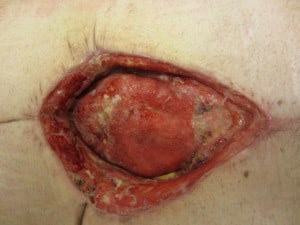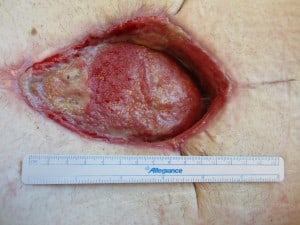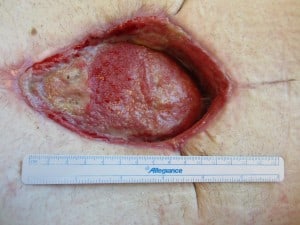Wound Care Treatment in Reno
Regenerative Wound Medicine
Stemming from the experience of blast wounds and shrapnel wounds from the Iraq war, advances have been made in the science of wound healing. For years, complex or chronic wounds have been treated often unsuccessfully with a combination of techniques including gauze dressing changes, vacuum assisted devices (wound vac), surgical skin grafting, hyperbaric oxygen chamber emersion and other methods. In all these cases the wound healing takes a long period of time and involves inconvenience as well as cost and in some cases physical discomfort.
In recent years many biomedical research laboratories have built upon the advances of cellular biology to develop graft materials that stimulate human tissue growth and wound healing. The category of product that the research laboratories developed is frequently referred to as extracellular matrix, or ECM.
But not all ECM materials work the same. Researchers in laboratories examining tissue and wound healing have learned that extracellular matrix material can result in either scarring on the one hand, or more functional tissue regeneration on the other. The healthier and more functional regeneration of actual muscle tissue and other organ tissue depends on the stimulation of specific human growth factors and specific healing cells. M1 macrophages are believed to be highly important in the stimulation of functional tissue regeneration and in the recruitment of the progenitor cells that lead to site specific tissue regrowth, such as functional muscle. Other macrophage subtypes generally simply result in scar.
Xcellistem, the newest extracellular matrix, was created by a company called Regenerative Tissue Technologies (RTT) and it was widely used in treating complex wounds from wartime injuries and led to remarkable results. Placed appropriately in wounds it stimulates M1 macrophages and brings specific growth factors to the tissue regeneration creating tissue specific functional healing. It markedly accelerates the time to healing.
Advanced wound medicine sometimes involves employing a number of different techniques to achieve wound healing for chronic or challenging wounds. It often requires surgical debridement of the scar and additional surgery to achieve wound healing. It also requires regular follow-up with our clinical wound healing experts.
If you are a patient in Reno who is in need of wound treatment candidates can set up an appointment with our doctors to learn more about our advanced healing therapy and regenerative medicine. Visit our contact page for appointments and questions. We are accepting patients from Carson City.
Wounds that can be healed in our clinic include:
- Diabetic ulcers
- Open extremity wounds
- Wounds after trauma
- Surgical wounds
- Pilonidal cyst wounds
- Subcutaneous or intramuscular wounds
If you or your loved one is struggling with a non-healing wound, whether that is an abdominal wound, a soft tissue extremity wound, a non-healing diabetic ulcer, or another type, please contact the appointment desk to consider consultation regarding wound treatment with advanced regenerative tissue growth matrix.
External Wound Care | Please be aware the attached images are graphic in nature
Complex wounds may arise from trauma, surgery, resection of tumors, ulcers from diabetes, and many other causes. Healing of complex wounds is impaired by factors such as diabetes, obesity, impaired arterial circulation, and immunosuppressive medications. The science of complex wound healing now includes the use of regenerative materials that have arisen from the research laboratory. Dr. Sasse and his team approach each wound care challenge on an individual basis with special care and individualized attention, using the best surgical and non-surgical techniques available to achieve healing.
Below is an example of how Dr. Sasse and his team achieve complete wound healing rapidly in a complex, deep abdominal wound.
In the first image, the open wound is treated with surgical debridement and placement of Xcellistem regenerative material
In the next image, 1 week later, the wound is re-inspected and more Xcellistem material is added in the office

The following image is taken 3 weeks after initial treatment, and shows granulation and healing of tissue

The next image 4 weeks postop, shows further healing taking place

Progress at 6 weeks of wound healing

Wound healing at eight weeks, now only superficial granulation bed



